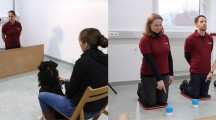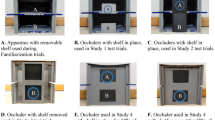Abstract
We tested domestic dogs (N = 16) in a Guesser–Knower task in which they chose between possible locations for hidden food indicated by human informants. In four experiments, the perceptual access of the Guesser and Knower to the hidden food baiting was manipulated. When informants had differing perceptual access to the baiting, dogs preferred the location indicated by the Knower from the start of testing (Experiment 1), even when baiting was done by a third experimenter (Experiments 2–3). However, when there was no difference in perceptual access and both informants either knew or did not know the food location, dogs had no preference between the informants (Experiment 4). Controls ruled out alternative explanations in terms of associative learning, unintentional and olfactory cues. Analysis of individual data showed no significant heterogeneity across dogs, and results were not correlated with age or sex. Dogs’ performances were superior to those of nonhuman primates in previous studies. Although a mentalistic explanation is not required, results add to evidence that dogs have a remarkable sensitivity to cues related to humans’ attentional state, which enables them to respond as if they had a functional theory of mind in the Guesser–Knower task with human informants.










Similar content being viewed by others
References
Agnetta B, Hare B, Tomasello M (2000) Cues to food location that domestic dogs (Canis familiaris) of different ages do and do not use. Anim Cogn 3:107–112
Bräuer J, Kaminski J, Riedel J, Call J, Tomasello M (2006) Making inferences about the location of hidden food: social dog, causal ape. J Comp Psych 120:38–47
Bugnyar T, Heinrich B (2005) Ravens, Corvus corax, differentiate between knowledgeable and ignorant competitors. Proc Royal Soc B 272:1641–1646
Butterworth G, Jarrett N (1991) What minds have in common is space: spatial mechanisms serving joint visual attention in infancy. Br J Dev Psych 9:55–72
Call J, Bräuer J, Kaminski J, Tomasello M (2003) Domestic dogs (Canis familiaris) are sensitive to the attentional state of humans. J Comp Psych 117:257–263
Clutton-Brock J (1995) Origins of the dog: domestication and early history. In: Serpell J (ed) The domestic dog: its evolution, behaviour, and interactions with people. Cambridge Univ Press, Cambridge, pp 7–20
Cooper JJ, Ashton C, Bishop S, West R, Mills DS, Young RJ (2003) Clever hounds: social cognition in the domestic dog (Canis familiaris). Appl Anim Behav Sci 81:229–244
Dally JM, Emery NJ, Clayton NS (2006) Foodcaching western scrub-jays keep track of who was watching when. Science 312:1662–1665
Dennett DC (1983) Intentional systems in cognitive ethology: the “Panglossian paradigm” defended. Behav Brain Sci 6:343–355
Gácsi M, Miklósi Á, Varga O, Topál J, Csányi V (2004) Are readers of our face readers of our minds? Dogs (Canis familiaris) show situation-dependent recognition of human’s attention. Anim Cogn 7:144–153
Hare B, Tomasello M (1999) Domestic dogs (Canis familiaris) use human and conspecific social cues to locate hidden food. J Comp Psych 113:173–177
Hare B, Tomasello M (2005) Human-like social skills in dogs? Trends Cog Sci 9:439–444
Hare B, Call J, Tomasello M (2001) Do chimpanzees know what conspecifics know? Anim Behav 61:771–785
Hare B, Brown M, Williamson C, Tomasello M (2002) The domestication of social cognition in dogs. Science 298:1634–1636
Held S, Mendl M, Devereux C, Byrne RW (2001) Behaviour of domestic pigs in a visual perspective taking task. Behav 138:1337–1354
Heyes CM (1994a) Social cognition in primates. In: Mackintosh NJ (ed) Animal learning and cognition. Academic Press, London, pp 281–305
Heyes CM (1994b) Cues, convergence and a curmudgeon: a reply to Povinelli. Anim Behav 48:242–244
Horowitz A (2011) Theory of mind in dogs? Examining method and concept. Learn Behav 39:314–317
Kaminski J, Bräuer J, Call J, Tomasello M (2009) Domestic dogs are sensitive to a human’s perspective. Behav 146:979–998
Kaminski J, Pitsch A, Tomasello M (2013) Dogs steal in the dark. Anim Cogn 16:385–394
Kuroshima H, Fujita K, Fuyuki A, Masuda T (2002) Understanding of the relationship between seeing and knowing by tufted capuchin monkeys (Cebus apella). Anim Cogn 5:41–48
Kuroshima H, Fujita K, Adachi I, Iwata K, Fuyuki A (2003) A capuchin monkey (Cebus apella) recognizes when people do and do not know the location of food. Anim Cogn 6:283–291
McKinley J, Sambrook TD (2000) Use of human-given cues by domestic dogs (Canis familiaris) and horses (Equus caballus). Anim Cogn 3:13–22
Miklósi Á, Polgárdi R, Topál J, Csányi V (1998) Use of experimenter-given cues in dogs. Anim Cogn 1:113–121
Miklósi Á, Topál J, Csányi V (2004) Comparative social cognition: what can dogs teach us? Anim Behav 67:995–1004
Miklósi A, Pongrácz P, Lakatos G, Topál J, Csányi V (2005) A comparative study of the use of visual communicative signals in interactions between dogs (Canis familiaris) and humans and cats (Felis catus) and humans. J Comp Psych 119:179–186
Miklósi Á, Topál J, Csányi V (2007) Big thoughts in small brains? Dogs as a model for understanding human social cognition. Neurorep 18:467–471
Moll H, Tomasello M (2006) Level 1 perspective‐taking at 24 months of age. Br J Dev Psych 24:603–613
Penn DC, Povinelli DJ (2007) On the lack of evidence that non-human animals possess anything remotely resembling a ‘theory of mind’. Phil Trans Royal Soc B Biol Sci 362:731–744
Penn DC, Holyoak KJ, Povinelli DJ (2008) Darwin’s mistake: explaining the discontinuity between human and nonhuman minds. Behav Brain Sci 31:109–130
Perner J (2000) Memory and theory of mind. The Oxford handbook of memory, Oxford, pp 297–312
Pfungst O (1911) Clever Hans (The Horse of Mr. Von Osten): a contribution to experimental animal and human psychology (translated: CL Rahn). Henry Holt and Company
Povinelli DJ (1994) Comparative studies of animal mental state attribution: a reply to Heyes. Anim Behav 48:239–241
Povinelli DJ, deBlois S (1992) Young children’s (Homo sapiens) understanding of knowledge formation in themselves and others. J Comp Psych 106:228–238
Povinelli DJ, Eddy TJ (1996) What young chimpanzees know about seeing. Mono Soc Res Child Dev 61:1–152
Povinelli DJ, Nelson KE, Boysen ST (1990) Inferences about guessing and knowing by chimpanzees (Pan troglodytes). J Comp Psych 104:203–210
Povinelli DJ, Parks KA, Novak MA (1991) Do rhesus monkeys (Macaca mulatta) attribute knowledge and ignorance to others? J Comp Psych 105:318
Povinelli DJ, Rulf AB, Bierschwale DT (1994) Absence of knowledge attribution and self-recognition in young chimpanzees (Pan Troglodytes). J Comp Psych 108:74–80
Premack D (1988) ‘Does the chimpanzee have a theory of mind’ revisited. In: Byrne RW, Whiten A (eds) Machiavellian intelligence: social expertise and the evolution of intellect in monkeys, apes, and humans. Clarendon Press/Oxford University Press, New York, NY, pp 160–179
Premack D, Woodruff G (1978) Does the chimpanzee have a theory of mind? Behav Brain Sci 4:515–526
Rilling M (1993) Invisible counting animals: a history of contributions from comparative psychology, ethology, and learning theory. In: Boysen ST, Capaldi EJ (eds) The development of numerical competence: animal and human models. Comparative cognition and neuroscience. Lawrence Erlbaum Associates, Hillsdale, NJ, pp 3–37
Scaife M, Bruner JS (1975) The capacity for joint visual attention in the infant. Nature 253:265–266
Schwab C, Huber L (2006) Obey or not obey? Dogs (Canis familiaris) behave differently in response to attentional states of their owners. J Comp Psych 120:169–175
Seligman MEP (1970) On the generality of the laws of learning. Psych Rev 77:406–418
Sodian B, Thoermer C, Dietrich N (2006) Two-to four-year-old children’s differentiation of knowing and guessing in a non-verbal task. Euro J Dev Psych 3:222–237
Soproni K, Miklósi Á, Topál J, Csányi V (2001) Comprehension of human communicative signs in pet dogs (Canis familiaris). J Comp Psych 115:122–126
Soproni K, Miklósi A, Topál J, Csányi V (2002) Dogs’ (Canis familiaris) responsiveness to human pointing gestures. J Comp Psych 116:27–34
Tomasello M, Call J, Hare B (2003a) Chimpanzees understand psychological states—the question is which ones and to what extent. Trends Cog Sci 7:153–156
Tomasello M, Call J, Hare B (2003b) Chimpanzees vs. humans: it’s not that simple. Trends Cog Sci 7:239–240
Topál J, Miklósi Á, Gácsi M, Dóka A, Pongrácz P, Kubinyi E et al (2009) The dog as a model for understanding human social behavior. Adv Study Behav 39:71–116
Tschudin AJ-PC (2006) Belief attribution tasks with dolphins: what social minds can reveal about animal rationality. In: Hurley S, Nudds M (eds) Rational animals?. Oxford Univ Press, New York, pp 412–436
Udell MAR, Wynne CDL (2008) A review of domestic dogs’ (Canis familiaris) human-like behaviors: or why behavior analysts should stop worrying and love their dogs. J Exp Anal Behav 89:247–261
Udell MAR, Giglio RF, Wynne CDL (2008) Domestic dogs (Canis familiaris) use human gestures but not nonhuman tokens to find hidden food. J Comp Psych 122:84–93
Udell MAR, Dorey NR, Wynne CDL (2011) Can your dog read your mind? Understanding the causes of canine perspective taking. Learn Behav 39:289–302
Virányi Z, Topál J, Gácsi M, Miklósi Á, Csányi V (2004) Dogs respond appropriately to cues of humans’ attentional focus. Behav Proc 66:161–172
Virányi Z, Topál J, Miklósi Á, Csányi V (2006) A nonverbal test of knowledge attribution: a comparative study on dogs and children. Anim Cogn 9:13–26
Wellman HM (1992) The child’s theory of mind. The MIT Press, Cambridge, MA
Whiten A, Perner J (1991) Fundamental issues in the multidisciplinary study of mindreading. In: Whiten A (ed) Natural theories of mind: evolution, development, and simulation of everyday mindreading. Basil Blackwell, Oxford, pp 1–18
Wilson EB (1927) Probable inference, the law of succession, and statistical inference. J Amer Stat Assoc 22:209–212
Wimmer H, Hogrefe G-J, Perner J (1988) Children’s understanding of informational access as source of knowledge. Child Dev 59:386–396
Author information
Authors and Affiliations
Corresponding author
Electronic supplementary material
Below is the link to the electronic supplementary material.
Supplementary material 1 (MOV 4317 kb)
Rights and permissions
About this article
Cite this article
Maginnity, M.E., Grace, R.C. Visual perspective taking by dogs (Canis familiaris) in a Guesser–Knower task: evidence for a canine theory of mind?. Anim Cogn 17, 1375–1392 (2014). https://doi.org/10.1007/s10071-014-0773-9
Received:
Revised:
Accepted:
Published:
Issue Date:
DOI: https://doi.org/10.1007/s10071-014-0773-9




